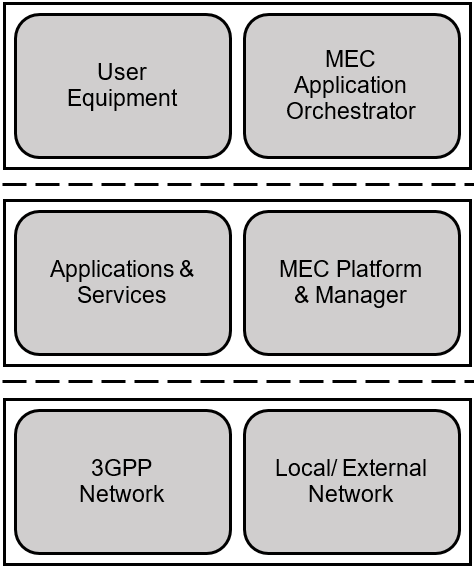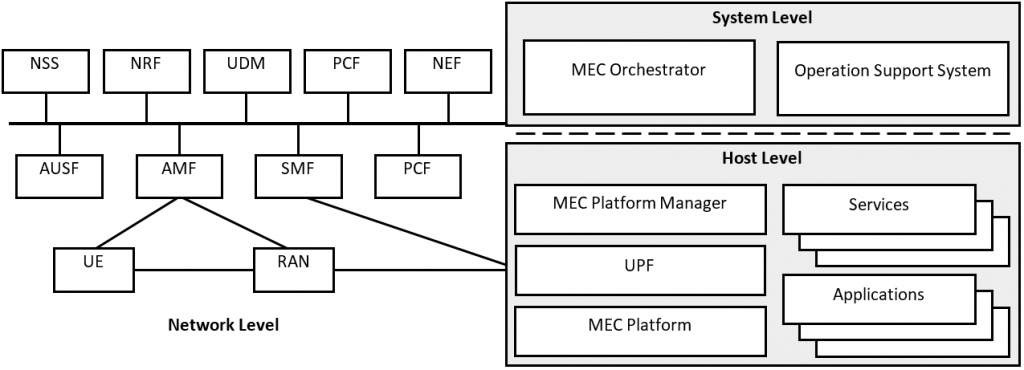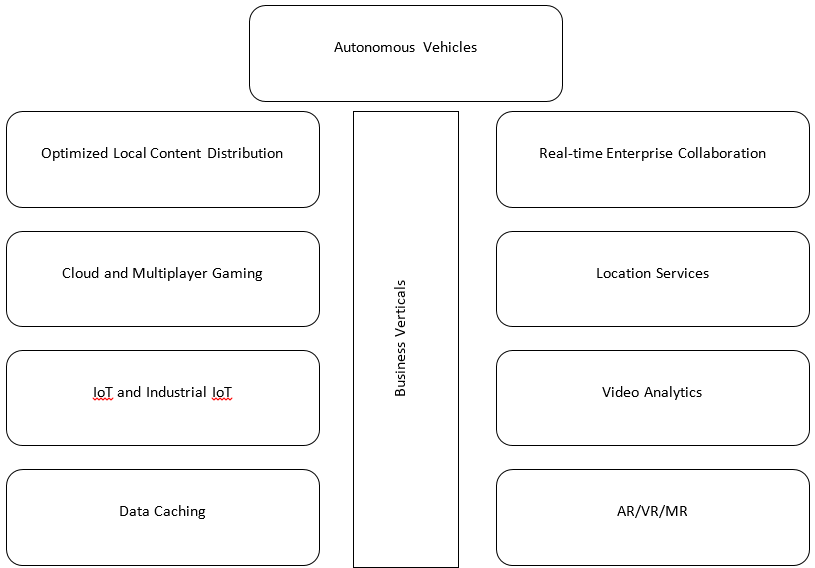MEC stands for Multi-access Edge Computing. Multi-access/ Mobile Edge Computing architecture brings computational capabilities, storage, and network services closer to the network edge, in proximity to end-users and data sources.
MEC deployments generally entail strategically placing edge servers or computing resources at the periphery of the network infrastructure. These edge locations include base stations, access points, or on-premises edge devices. Strategically positioned edge nodes also minimize the distance between data sources and processing, resulting in reduced latency and improved responsiveness.
By utilizing MEC, data processing, analytics, and other computational tasks can be executed at the edge, closer to the source of data generation. This approach reduces reliance solely on centralized cloud servers, enabling faster response times, better control over data transmission, and more efficient utilization of network resources.
The Evolution Of Multi-access Edge Computing
Several factors and technological advancements drive the evolution of edge computing and, subsequently, Multi-Access Edge Computing.

Figure 1: Evolution of Multi-access Edge Computing
In the 2010s, companies introduced cloud computing or micro data centers during the boom of cloud-based applications and businesses. These centers rented their computing resources and storage to the public via clouds.
- In the early 2020s, edge computing emerged due to the escalating quantity of data produced by diverse sources, including Internet of Things (IoT) devices and sensors. This approach involves conducting computation and data processing at the edge, which is closer to the origin of data generation, as opposed to utilizing cloud-based solutions.
- Now, due to mobile devices’ demand for high computation resources and low latency, multi-access edge computing, where the edge server is installed on the network itself, has been introduced.
Why Did The Need For MEC Arise?
While both Edge Computing and MEC address computing at the network edge, MEC focuses explicitly on the mobile network context, addressing the unique requirements and opportunities associated with mobile devices, networks, and applications. A few of these are listed below:-
- The proliferation of IoT Devices
- Distributed Data and Application Architecture
- Network Virtualization and Software-Defined Networking
- Low-Latency and Real-Time Applications
- Edge Intelligence and Data Processing
- Bandwidth Optimization with improved QoS

Multi-access Edge Computing Framework
The figure illustrates the framework for Multi-access Edge Computing, dividing it into three sections: system level, host level, and network level.
The System Level is responsible for several management tasks, including handling MEC Application Instantiation requests from user applications and examining application requirements.
The Host Level provides computational resources and executes edge applications closer to the end-users or devices, reducing network congestion.
Network Level refers to the underlying infrastructure enabling communication and connectivity between the MEC hosts, devices, and the core network.
Integration Of MEC In 5G Network
5G network architecture allows MEC providers to integrate the MEC framework in the 5G core network. The below figure shows the deployment of the MEC framework within the 5G core network:

Figure 3: Integrated MEC deployment in 5G core network
The system-level section comprises an MEC orchestrator, which acts as an application function in the control plane. It is indirectly connected to the user equipment (UE) via the core network and RAN. It receives information related to UE requirements, capabilities, etc., and uses this information to make decisions and allocate appropriate resources within the MEC environment.
They implement the host level section and the user plane function (UPF) of the 5G network. The host-level section comprises the MEC platform, platform manager, MEC applications, and microservices. The MEC platform provides the infrastructure and resources required to host and execute edge applications. Further, the platform manager manages and operates the MEC platform, ensuring its efficient functioning and maintenance. The network level section controls connectivity to 3GPP networks and local area networks and provides the communication front to the user equipment for communication with the MEC environment.
MEC Deployment Scenarios In 5G Infrastructure
Based on the application requirements, there are multiple deployment scenarios are possible for MEC within the 5G core network. Some of the scenarios are mentioned below:

Figure 4: MEC Deployment Scenarios in 5G Infrastructure
Moving MEC From 4G To 5G
The Key difference between MEC deployment with 4G and MEC deployment with 5G is –
Base Stations: In 4G, base stations provide wireless connectivity to devices and transmit and receive data between them and the MEC servers. Typically, the MEC Servers are standalone servers. Additionally, in 5G, the base station (gNodeB or gNB) incorporates the MEC server’s functionality within itself, enabling direct communication and computation at the edge without the need for a separate interface.
Virtualization: 5G introduces a higher level of virtualization compared to 4G. It allows for network slicing. This implies that the network infrastructure can be divided into virtualized slices to cater to different application requirements.
Access Technologies: 4G MEC primarily focuses on cellular networks, while 5G MEC architecture expands its reach to encompass multiple access technologies, including cellular (5G, 4G), Wi-Fi, and fixed-line broadband.
Role of ETSI Standard Organization in MEC
ETSI ISG MEC is a pioneering force in next-generation technologies. The organization also dedicates its expertise to producing accurate and timely specifications. These specifications foster the seamless integration of Multi-Access Edge Computing (MEC) technologies with exceptional interoperability.
The ETSI ISG MEC Proof of Concept Framework brings to life a multitude of innovative MEC proofs of concept. These demonstrations not only showcase MEC technologies’ workability and potential. They also act as a catalyst for progress and knowledge sharing within the industry. At the core of its mission, ETSI ISG MEC actively supports and nurtures the burgeoning MEC ecosystem.
MEC Proofs of Concept aims to show that the technology is workable. The ISG MEC receives feedback from the results. Below are a few of the MEC POCs projects on which ISG is currently working:

Figure 5: ETSI Projects Related to Multi-access Edge Computing
Business Models For Telecos In MEC
Multi-access Edge Computing has been in the market for a while; below are 5 basic businesses in which Telecom companies operate:
- Dedicated Edge Hosting – Companies can manage edge-located compute/storage resources already installed at the Telecom operator’s network.
- Edge IaaS/PaaS/NaaS – Companies have the ability to offer users distributed compute and storage capabilities. They can also provide a platform for creating applications on the edge infrastructure and network services. Additionally, companies can offer APIs and virtual network functions (VNFs) in an ‘as-a-service’ fashion through a cloud portal as the customer interface.
- Systems integration – Companies can provide specialized turn-key solutions for business clients with needs that (partially) rely on MEC’s capability.
- B2B2x solutions – Companies can offer corporate clients edge-enabled solutions. The client may use these for internal objectives, such as to enhance current processes. Alternatively, they may support a B2B2X (business-to-business-to-consumer) offering.
- End-to-end consumer retail applications – Teleco can offer digital services for consumer applications. These MEC-enabled services will use MEC’s advantages, such as low latency, high throughput, and context awareness. These advantages will enable the providers to offer customers cutting-edge services, such as VR for live sports.
Markets Aspects Of MEC
As per Stellarix’s findings, the Multi-Access Edge Computing Market is anticipated to see a CAGR of 31% from 2022 to 2028, growing from USD 0.4 billion in 2021 to a market value of about USD 2.7 billion. Below are the major players playing an essential role in the growth of MEC technology.

Figure 6: Key Players
Recent Market Activities
Below are the recent Merger’s and collaborations between the major players to boost innovation and business –
In March 2023, NVIDIA released NVIDIA CloudXR, which will enable users to customize SDK for their applications and customers and scale extended reality (XR) deployment across the cloud, 5G Mobile Compute Edge (MEC), and corporate networks
In February 2023, Cisco and Intel collaborated to promote private 5G innovation and worldwide IoT adoption. Moreover, the businesses will work on Edge AI frameworks based on Intel’s Xeon Processor and Intel’s smart edge for multi-access edge computing. They will also focus on RAN solutions to optimize and improve the performance of Cisco Private 5.
In February 2023, Qualcomm and American Tower partnered to boost the next-generation edge computing ecosystem. Also, they are developing a multi-access edge compute solution with a heterogeneous computing architecture combined with Qualcomm AI Engine. Moreover, the design aims to reliably run dynamic, process-intensive applications like mobile cloud gaming, video transcoding, etc.
In January 2023, Advantech Co., Ltd. announced the launch of an NVIDIA Jetson AGX Orin-based AI computer system called MIC-733-AO. In addition, the creators designed this system to offer better computing power, versatile video input support, and wireless connectivity. It was specifically created to cater to the emerging trend of Video + AI + 5G applications.
Moreover, in November 2022, Vodafone entered into a partnership with Kyndryl to provide its esteemed customers with proficient and supervised services for exclusive Multi-access Edge Computing (MEC) and bigger cloud-managed services.
Additionally, in October 2022, Cognizant extended its partnership with Qualcomm to open 5G centers in Atlanta, Bangalore, and other cities. The centers will allow clients to imagine, test, and deploy next-generation solutions. Combining private 5G networks with Multi-Access Edge Computing technology will also achieve this.
Other Business Applications Of MEC
The Key players mentioned above are operating in different business verticals, which came into play after the introduction of Multi-access Edge computing –

Figure 7: Business Applications
Where Is The MEC Infrastructure Hosted?
In general, organizations tend to deploy and host Mobile Edge Computing (MEC) infrastructure at the periphery of the network, in closer proximity to the end users or devices that generate data. The virtualization infrastructure facilitates the provision of computing, storage, and network resources to mobile edge applications. Furthermore, MEC offers cloud computing functionalities and establishes an IT service environment at the network’s edge.
One can deploy the MEC application server at the macro base station EnodeB, which is part of an LTE cellular network. Alternatively, it can be deployed on the Radio Network. MEC also allows hosting applications and services ‘on top’ of the mobile network elements, i.e., above the network layer.
Conclusion
Multi-Access Edge Computing (MEC) is an innovative technology that facilitates computation and data storage’s proximity to the end user. It enables real-time processing, reduced latency, and improved performance. Moreover, as the demand for low-latency applications increases, experts expect substantial growth in the MEC market in the coming years. Industries such as healthcare, retail, smart cities, and gaming are embracing MEC to enhance user experiences and optimize operations. Additionally, MEC enables these industries to unlock new opportunities.